Dynamic Characteristics of Drought Conditions during the Growth of Winter Wheat Based on an Improved SWAT Model
Abstract
:1. Introduction
2. Materials and Methods
2.1. Study Area
2.2. Data Source
2.3. Improvement of the SWAT Model
- The occurrence of drought events during the growth of winter wheat is affected more by irrigation activities. Therefore, a real-time crop irrigation module was developed in the SWAT model to simulate the real-time and dynamic impact exerted by irrigation activities on the irrigation district (Figure 2). Based on the real-time monitoring data of the soil moisture content, this module calculates the real-time soil moisture in the irrigation area and deduces the real-time water demand (M) of the crop according to current hydrological and meteorological data and crop growth conditions. Next, the model compares the predicted precipitation (P) and the real-time water demand (M) and suggests if irrigation is required in the experimental region. If irrigation is required, the irrigation water shortage (WD) is calculated by subtracting the real-time water demand (M) from predicted precipitation (P). If irrigation is not required, then the next HRU (Hydrologic Research Unit) is activated. This module can accurately simulate the relative soil moisture and irrigate in the real-time during the crop growth period, thus improving the accuracy of the simulation and making the results of this paper more accurate [33].
- The soil water balance formula in the SWAT model was improved based on the real-time prediction of irrigated water shortage (WD), and the real-time irrigation amount was introduced as an index that can influence soil moisture content (Formula (1)). As the sources of water in the soil, both precipitation and irrigation levels were taken into consideration to study the dynamic simulation of soil moisture content in the experimental area (Formula (2)).
2.4. Rationality Verification of the Model
2.4.1. Parameter Calibration and Verification of Measured Data
2.4.2. Validation of Typical Events
2.5. Assessment Index and Grading of Agricultural Drought
3. Results and Discussions
3.1. Dynamic Characteristics of Drought Events during the Growth of Winter Wheat
3.1.1. Variation Characteristics of Relative Soil Moisture during Different Growth Stages of Winter Wheat
3.1.2. Interannual Variation and Frequency of Drought during Different Growth Stages of Winter Wheat
3.2. Spatial Distribution Characteristics of Drought in Winter Wheat
4. Conclusions
Author Contributions
Funding
Institutional Review Board Statement
Informed Consent Statement
Data Availability Statement
Conflicts of Interest
References
- Sai, M.V.R.S.; Murthy, C.S.; Chandrasekar, K.; Jeyaseelan, A.T.; Diwakar, P.G.; Dadhwal, V.K. Agricultural drought: Assessment & monitoring. Mausam 2021, 67, 131–142. [Google Scholar] [CrossRef]
- Liu, Y.; Huang, S.; Fang, W. Propagation and dynamic change of meteorological drought to hydrological drought in different seasons. J. Hydraul. Eng. 2021, 52, 93–102. [Google Scholar]
- Yonas, T. Perception of agricultural drought resilience in South Africa: A case of smallholder livestock farmers. J. Disaster Risk Stud. 2021, 13, e1–e11. [Google Scholar]
- Shashikant, V.; Shariff, A.M.; Wayayok, A.; Kamal, R.; Lee, Y.; Takeuchi, W. Utilizing TVDI and NDWI to Classify Severity of Agricultural Drought in Chuping, Malaysia. Agronomy 2021, 11, 1243. [Google Scholar] [CrossRef]
- Du, C.; Chen, J.; Nie, T. Spatial–temporal changes in meteorological and agricultural droughts in Northeast China: Change patterns, response relationships and causes. Nat. Hazards 2021, 110, 155–173. [Google Scholar] [CrossRef]
- Cui, Y.; Zhang, B.; Huang, H.; Wang, X.; Zeng, J.; Jiao, W.; Yao, R. Identification of Seasonal Sub-Regions of the Drought in the North China Plain. Water 2020, 12, 3447. [Google Scholar] [CrossRef]
- Chen, L.; Yang, X.; Ba, D.; Xue, S. Determination and application of the dynamic drought-monitoring indexes for agriculture in Gansu province. Agric. Res. Arid. Areas 2005, 01, 144–148+156. [Google Scholar]
- Ma, X.; Yao, Y.; Xu, Y. A Model for Dynamic Assessment of Crop Yield Losses from Drought and Its Tryout in Anhui Province. J. Catastrophol. 2010, 25, 13–17. [Google Scholar]
- Prodhan, F.; Zhang, J.; Yao, F.; Shi, L.; Sharma, T.P.; Zhang, D.; Cao, D.; Zheng, M.; Ahmed, N.; Mohana, H. Deep Learning for Monitoring Agricultural Drought in South Asia Using Remote Sensing Data. Remote Sens. 2021, 13, 1715. [Google Scholar] [CrossRef]
- Mishra, A.K.; Singh, V.P. A review of drought concepts. J. Hydrol. 2010, 391, 202–216. [Google Scholar] [CrossRef]
- Li, F.; Li, H.; Lu, W.; Zhang, G.; Kim, J.-C. Meteorological Drought Monitoring in Northeastern China Using Multiple Indices. Water 2019, 11, 72. [Google Scholar] [CrossRef] [Green Version]
- Chen, S.; Thian, Y.; Tan, X. Assessment of CFSR, ERA-Interim, JRA-55, MERRA-2, NCEP-2 reanalysis data for drought analysis over China. Clim. Dyn. 2019, 53, 737–757. [Google Scholar] [CrossRef]
- Zhang, R.; Chen, Z.; Xu, L.-J.; Ou, C.-Q. Meteorological drought forecasting based on a statistical model with machine learning techniques in Shaanxi province, China. Sci. Total Environ. 2019, 665, 338–346. [Google Scholar] [CrossRef] [PubMed]
- Xia, L.; Zhao, F.; Mao, K.; Yuan, Z.; Zuo, Z.; Xu, T. SPI-Based Analyses of Drought Changes over the Past 60 Years in China’s Major Crop-Growing Areas. Remote Sens. 2018, 10, 171. [Google Scholar] [CrossRef] [Green Version]
- Liu, Y.; Hwang, Y. Improving drought predictability in Arkansas using the ensemble PDSI forecast technique. Stoch. Hydrol. Hydraul. 2014, 29, 79–91. [Google Scholar] [CrossRef]
- Wang, W.; Huang, J.; Cui, W. Comparison of drought indices for remote sensing drought monitoring in Yunnan-Guizhou Plateau region. Trans. Chin. Soc. Agric. Eng. 2018, 34, 131–139+309. [Google Scholar]
- Du, L.; Tian, Q.; Wang, L. A synthesized drought monitoring model based on multi-source remote sensing data. Trans. Chin. Soc. Agric. Eng. 2014, 30, 126–132. [Google Scholar]
- Choudhary, R.; Athira, P. Effect of root zone soil moisture on the SWAT model simulation of surface and subsurface hydrological fluxes. Environ. Earth Sci. 2021, 80, 1–16. [Google Scholar] [CrossRef]
- Sun, F.; Mejia, A.; Zeng, P.; Che, Y. Projecting meteorological, hydrological and agricultural droughts for the Yangtze River basin. Sci. Total Environ. 2019, 696, 134076. [Google Scholar] [CrossRef]
- Arnold, J.G.; Srinivasan, R.; Muttiah, R.S.; Williams, J.R. large area hydrologic modeling and assessment part I: Model development. JAWRA J. Am. Water Resour. Assoc. 1998, 34, 73–89. [Google Scholar] [CrossRef]
- McDaniel, R.L.; Munster, C.; Nielsen-Gammon, J. Crop and Location Specific Agricultural Drought Quantification: Part III. Forecasting Water Stress and Yield Trends. Trans. ASABE 2017, 60, 741–752. [Google Scholar] [CrossRef]
- Chen, Y.; Marek, G.; Marek, T.; Brauer, D.; Srinivasan, R. Improving SWAT auto-irrigation functions for simulating agricultural irrigation management using long-term lysimeter field data. Environ. Model. Softw. 2018, 99, 25–38. [Google Scholar] [CrossRef]
- Sun, L.; Chen, X.; Pei, Z. Drought monitoring of upper and middle reaches of Qingjiang Basin based on SWAT model. Trans. Chin. Soc. Agric. Eng. 2014, 30, 129–137. [Google Scholar]
- Li, Y.; Liang, Z.; Zhao, W. Evaluation Method and Its Application of Agricultural Drought Based on SWAT Model. South-North Water Transf. Water Sci. Technol. 2014, 12, 7–11. [Google Scholar]
- Wang, F.; Wang, J.; Shi, J. Study on Simulation of Agricultural Drought in a Region Based on SWAT Model. J. North China Univ. Water Resour. Electr. Power 2019, 40, 64–70. [Google Scholar]
- Bian, Y.; Huang, F.; Cao, H. Analysis of Diversion Capacity of Sanliuzhai Irrigation Area on the Lower Yellow River. Yellow River 2019, 41, 152–156. [Google Scholar]
- Henan Jiuzheng Engineering Consulting Co., Ltd. Preliminary Design Text of 666.7 Hectares High Standard Farmland Construction Project in Yaojia Town, Zhongmou County in 2021; Henan Jiuzheng Engineering Consulting Co., Ltd.: Zhengzhou, China, 2021; pp. 17–25. [Google Scholar]
- Sachin, N.; Ashwini, K.; Sangita, S. Soil Erodibility Estimation for Soil Conservation in Dapoli Region of Maharashtra. Trends Biosci. 2014, 7, 486–490. [Google Scholar]
- Navideh, N.; Latif, K.; Sabahattin, I. Water quality prediction using SWAT-ANN coupled approach. J. Hydrol. 2020, 590, 125220. [Google Scholar]
- Harikrishna, S.; Sanat, N. A Methodological Framework for Identification of Baseline Scenario and Assessing the Impact of DEM Scenarios on SWAT Model Outputs. Water Resour. Manag. 2020, 34, 4795–4814. [Google Scholar]
- Hanna, K.; Paul, M.; Negahban-Azar, M.; Shirmohammadi, A. Developing a Decision Support System for Economic Analysis of Irrigation Applications in Temperate Zones. Water 2021, 13, 2044. [Google Scholar] [CrossRef]
- Ferreira, A.; de Almeida, A.; Koide, S.; Minoti, R.; Siqueira, M. Evaluation of Evapotranspiration in Brazilian Cerrado Biome Simulated with the SWAT Model. Water 2021, 13, 2037. [Google Scholar] [CrossRef]
- Zhang, Z.; Ma, J. Research and application of real—Time online irrigation management system for winter wheat in North China based on B/S mode. J. Arid. Land Resour. Environ. 2015, 29, 120–125. [Google Scholar]
- Liu, L.; Luo, Y. Effects of Different Irrigation Systems on the Relationship between Crops and Water in the Irrigation Districts along the Lower Reaches of the Yellow River. J. Irrig. Drain. 2011, 30, 5–10. [Google Scholar]
- Luo, Y.; He, C.; Sophocleous, M.; Yin, Z.; Hongrui, R.; Ouyang, Z. Assessment of crop growth and soil water modules in SWAT2000 using extensive field experiment data in an irrigation district of the Yellow River Basin. J. Hydrol. 2008, 352, 139–156. [Google Scholar] [CrossRef]
- Li, Z. Nearly 35% of Small Reservoirs in Henan Suffered the Worst Drought in 63 Years [EB/OL]. 2014. Available online: http://news.youth.cn/gn/201407/t20140728_5568520.htm (accessed on 5 November 2021).
- Duan, H.; Wang, S.; Feng, J. National drought situation in 2010 and its influence and causes. J. Arid. Meteorol. 2011, 29, 126–132. [Google Scholar]
- Ma, J. Zhengzhou Suffered the Worst Drought in 50 Years, 1.67 Million mu of Farmland and 130000 People were Affected [EB/OL]. 2009. Available online: http://finance.ifeng.com/a/20090205/352190_0.shtml (accessed on 5 November 2021).
- Ministry of Water Resources of the People’s Republic of China. Standard of Drought Grade for Water Conservancy Industry of the People’s Republic of China: SL424-008; China Water & Power Press: Beijing, China, 2009. [Google Scholar]
- Gong, Y.; Ji, X.; Hong, X.; Cheng, S. Correlation Analysis of Landscape Structure and Water Quality in Suzhou National Wetland Park, China. Water 2021, 13, 2075. [Google Scholar] [CrossRef]
- Perz, A.; Sobkowiak, L.; Wrzesiński, D. Spatial Differentiation of the Maximum River Runoff Synchronicity in the Warta River Catchment, Poland. Water 2020, 12, 1782. [Google Scholar] [CrossRef]
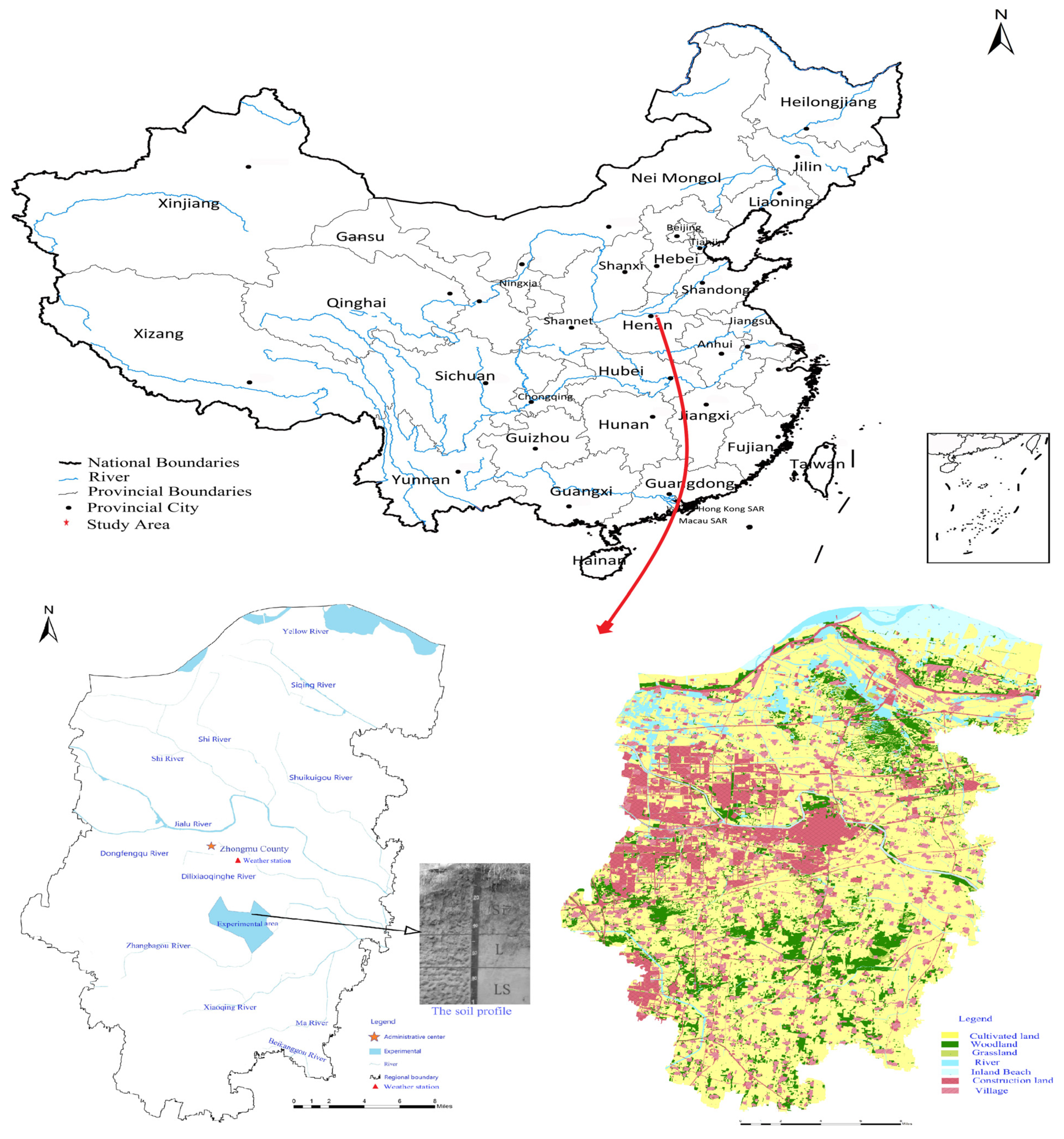
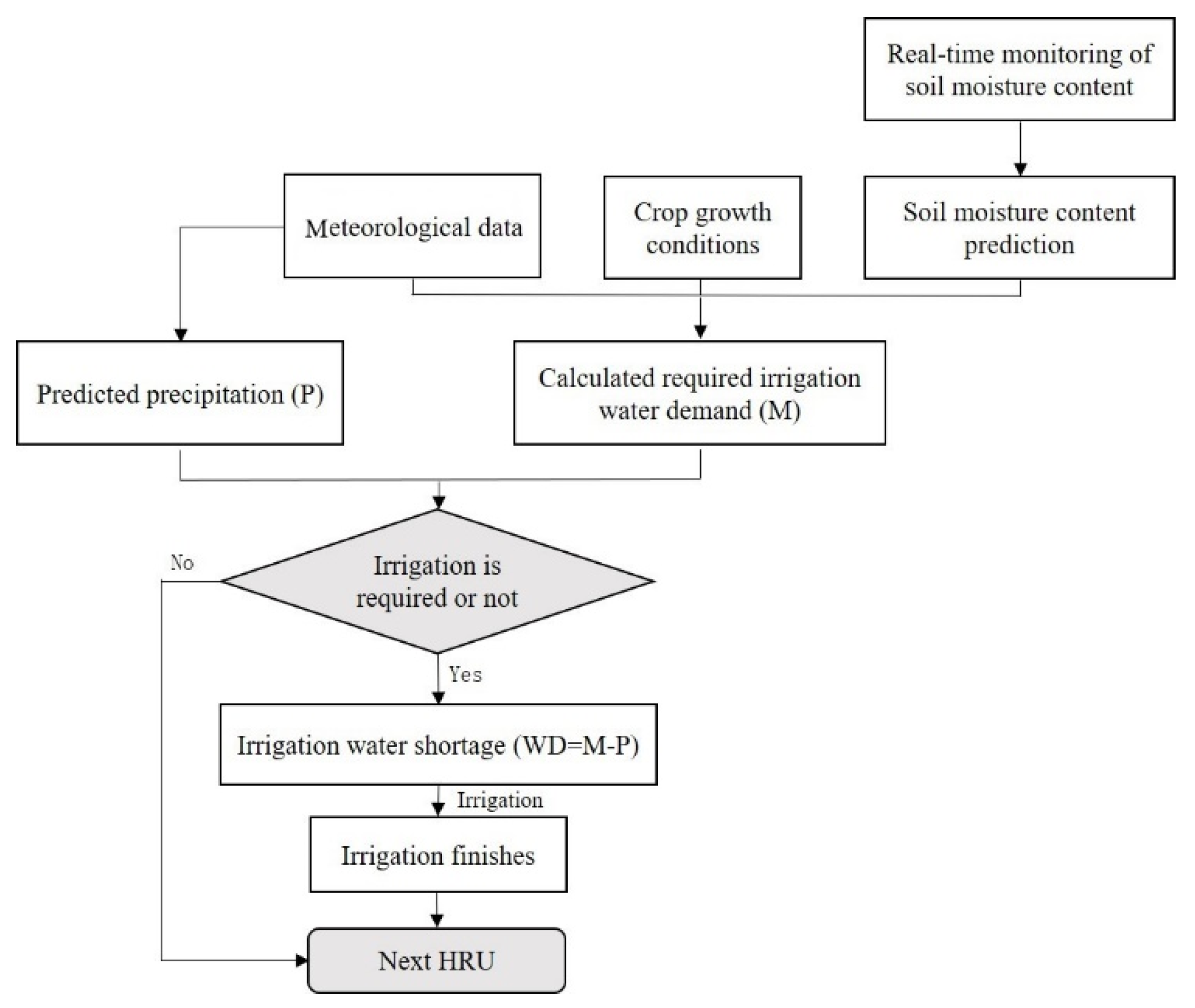
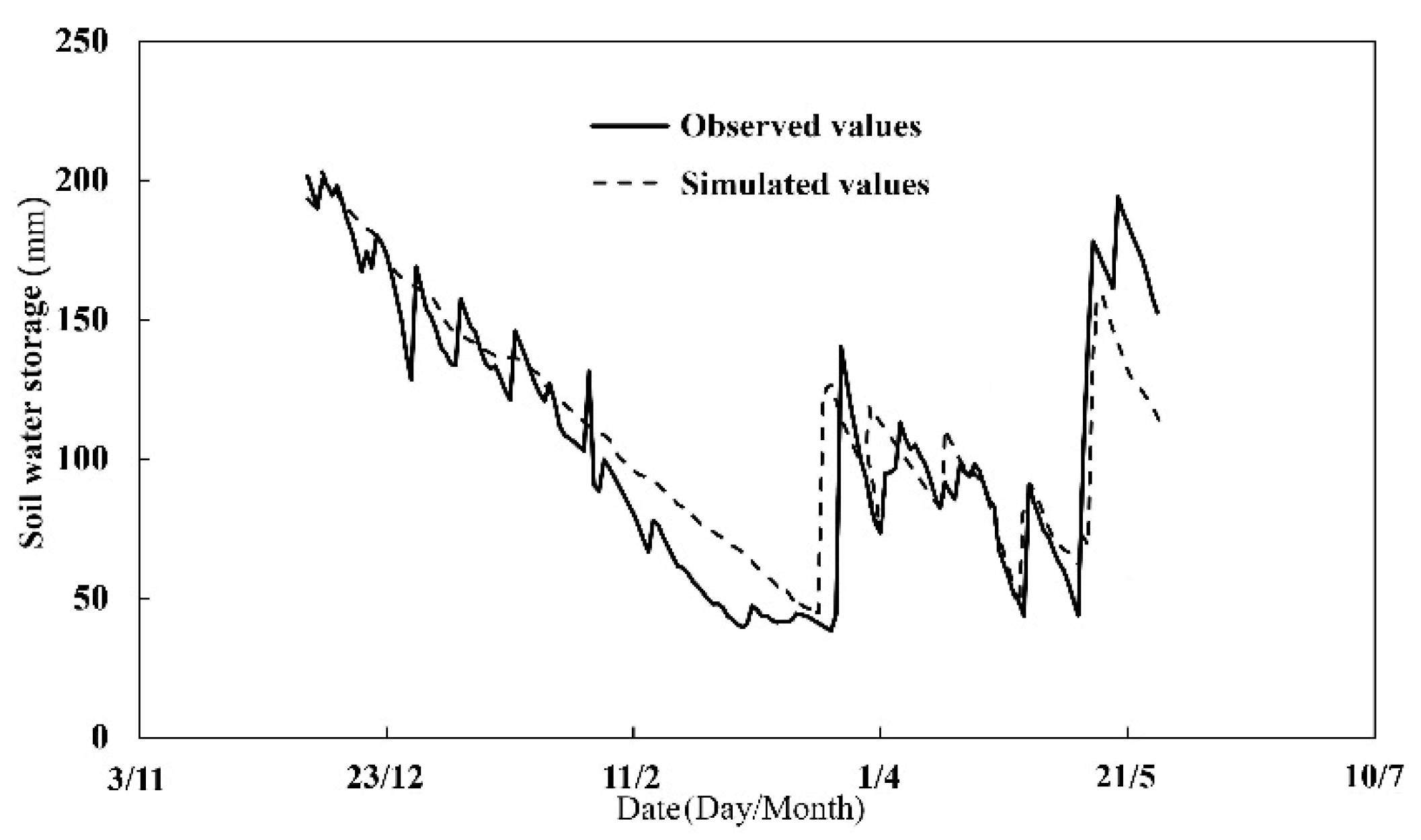
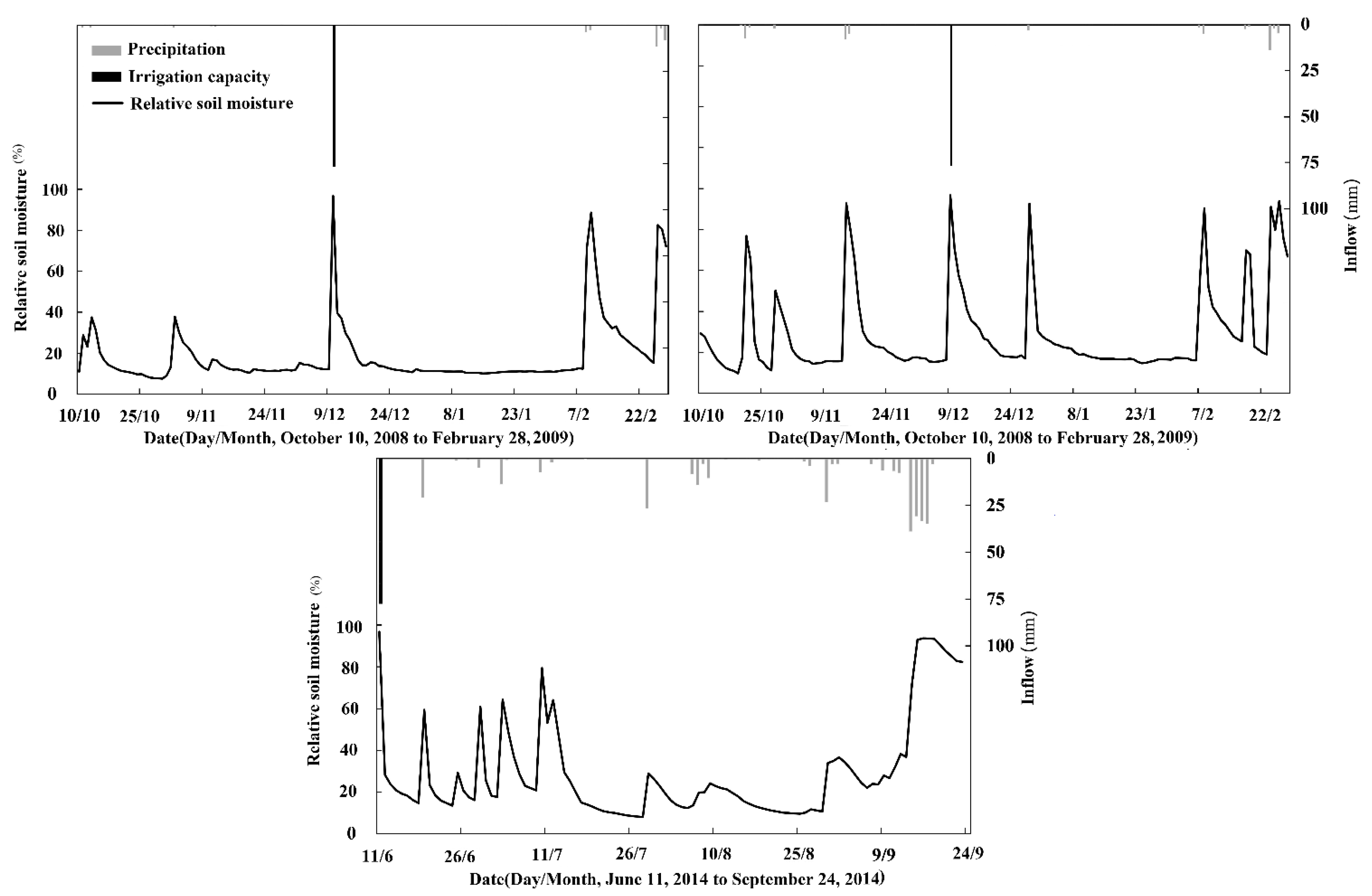
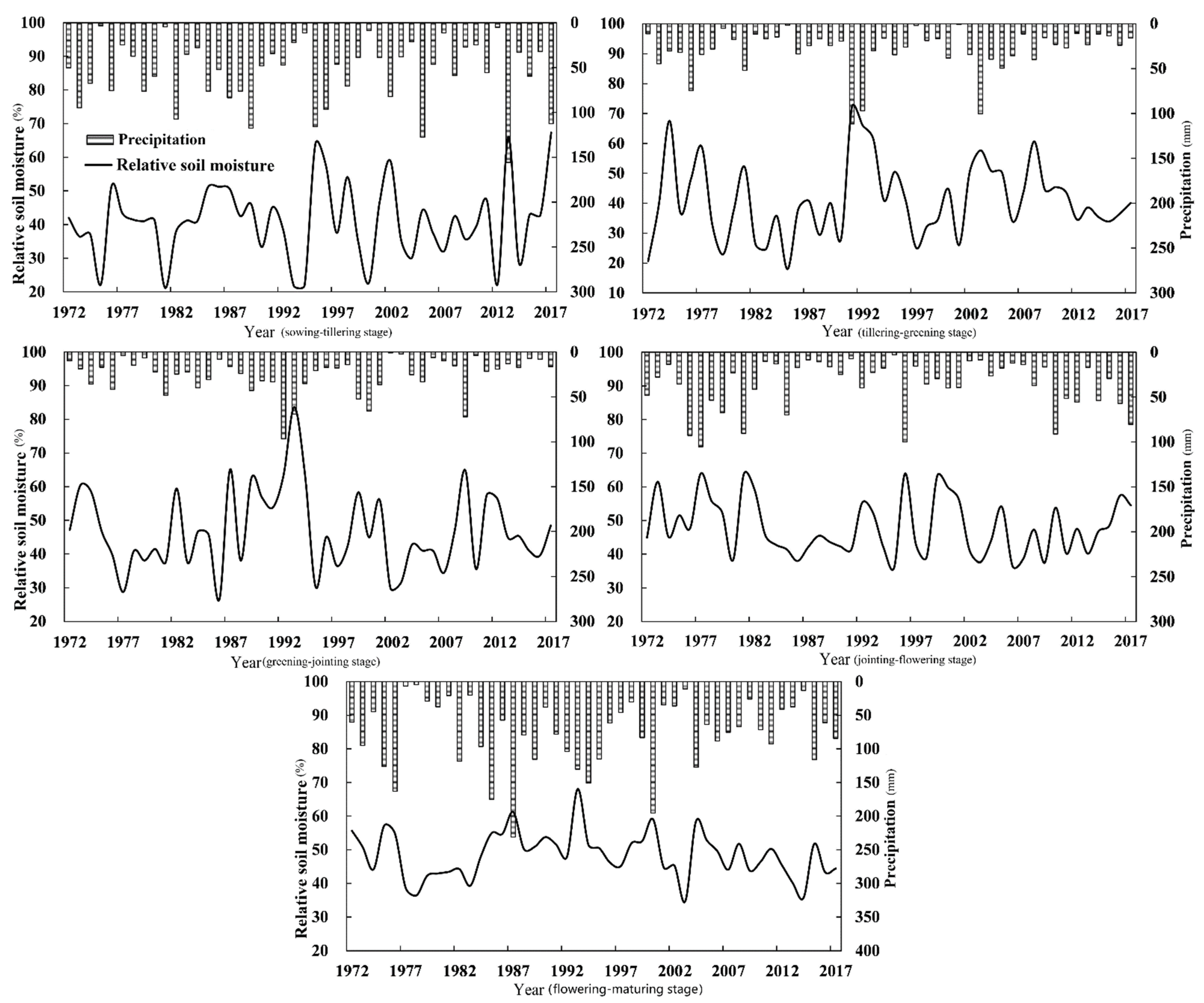
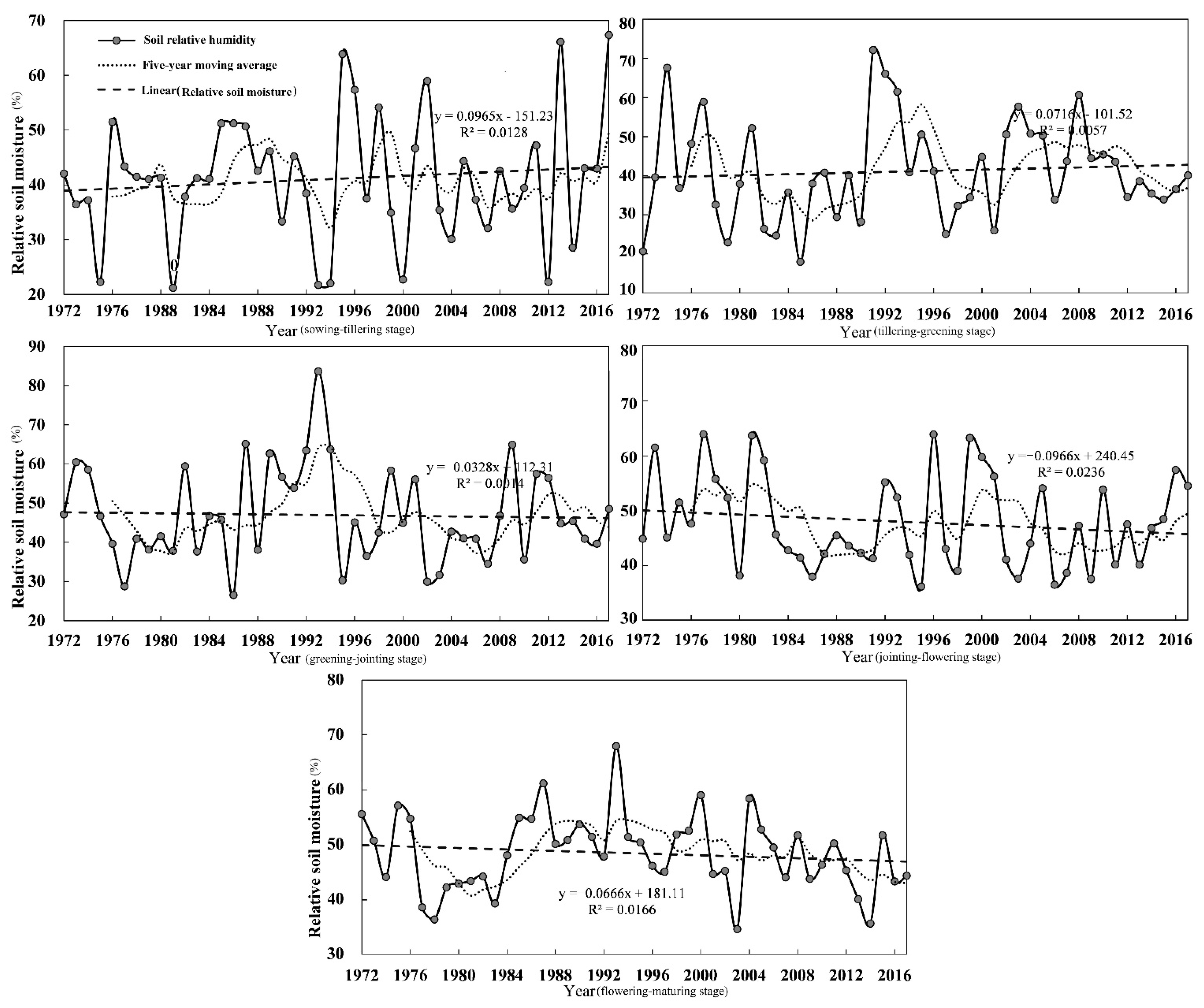
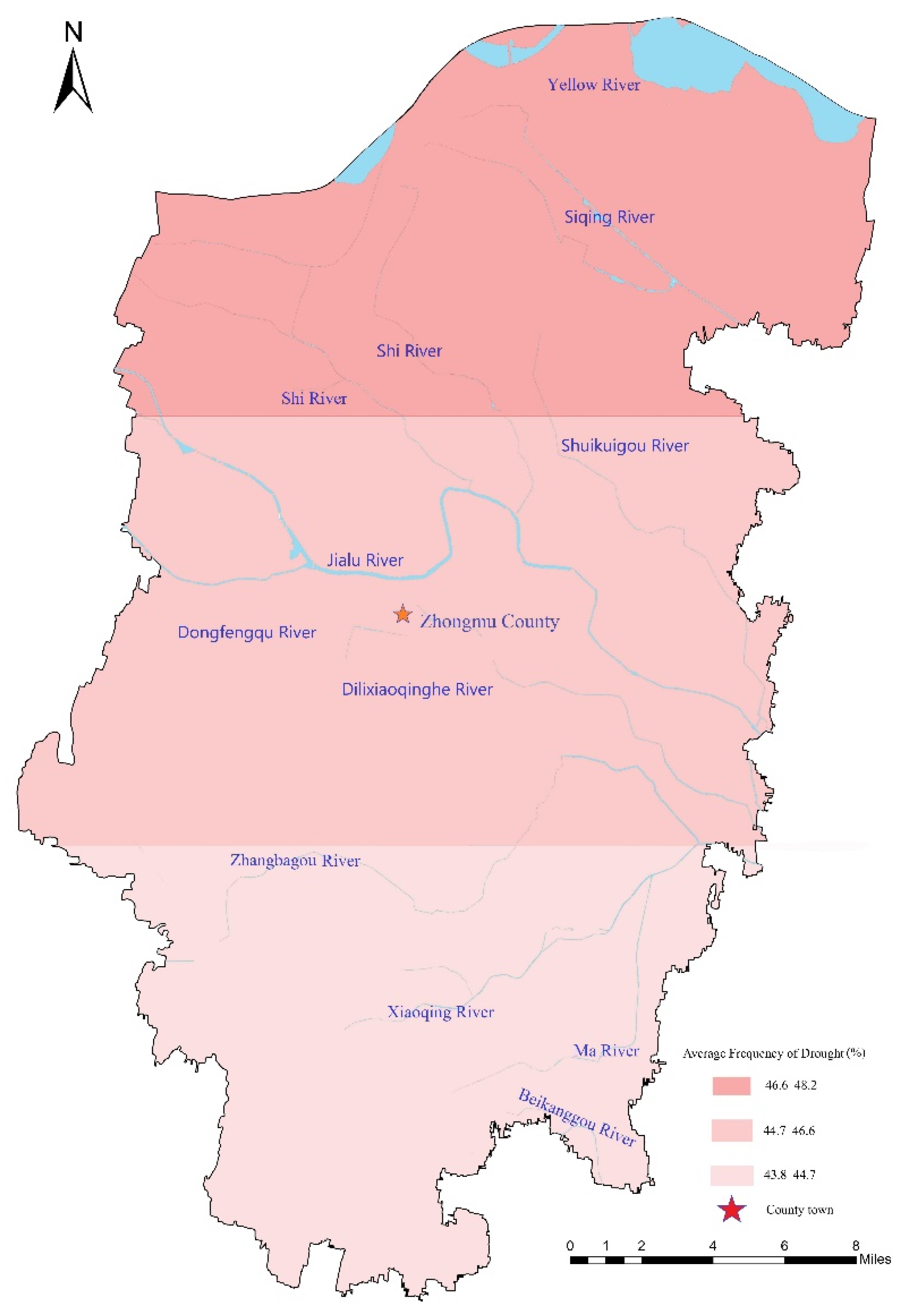
| Drought Grade | Light Drought | Moderate Drought | Severe Drought | Extra-Severe Drought |
|---|---|---|---|---|
| Relative Soil Moisture W (%) | 50 < W ≤ 60 | 40 < W ≤ 50 | 30 < W ≤ 40 | W ≤ 30 |
Publisher’s Note: MDPI stays neutral with regard to jurisdictional claims in published maps and institutional affiliations. |
© 2022 by the authors. Licensee MDPI, Basel, Switzerland. This article is an open access article distributed under the terms and conditions of the Creative Commons Attribution (CC BY) license (https://creativecommons.org/licenses/by/4.0/).
Share and Cite
Ma, J.; Cui, B.; Liu, L.; Hao, X.; Liang, F.; Jiang, Z.; Yang, J. Dynamic Characteristics of Drought Conditions during the Growth of Winter Wheat Based on an Improved SWAT Model. Water 2022, 14, 566. https://doi.org/10.3390/w14040566
Ma J, Cui B, Liu L, Hao X, Liang F, Jiang Z, Yang J. Dynamic Characteristics of Drought Conditions during the Growth of Winter Wheat Based on an Improved SWAT Model. Water. 2022; 14(4):566. https://doi.org/10.3390/w14040566
Chicago/Turabian StyleMa, Jianqin, Bifeng Cui, Lei Liu, Xiuping Hao, Feng Liang, Zhongfeng Jiang, and Jiangshan Yang. 2022. "Dynamic Characteristics of Drought Conditions during the Growth of Winter Wheat Based on an Improved SWAT Model" Water 14, no. 4: 566. https://doi.org/10.3390/w14040566
APA StyleMa, J., Cui, B., Liu, L., Hao, X., Liang, F., Jiang, Z., & Yang, J. (2022). Dynamic Characteristics of Drought Conditions during the Growth of Winter Wheat Based on an Improved SWAT Model. Water, 14(4), 566. https://doi.org/10.3390/w14040566






